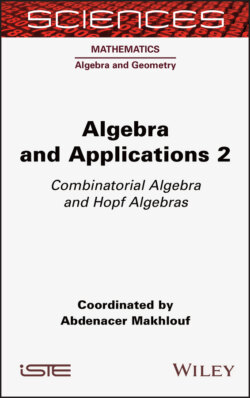Читать книгу Algebra and Applications 2 - Группа авторов - Страница 50
1.7.4. Dendriform algebras
ОглавлениеA dendriform algebra (Loday 2001) over the field k is a k-vector space A endowed with two bilinear operations, denoted ≺ and ≻ and called right and left products, respectively, subject to the three axioms below:
[1.119]
[1.120]
[1.121]
We readily verify that these relations yield associativity for the product
[1.122]
However, at the same time-ordering, the dendriform relations imply that the bilinear product ⊳ defined by:
[1.123]
is left pre-Lie. The associative operation * and the pre-Lie operation ⊳ define the same Lie bracket, and this is, of course, still true for the opposite (right) pre-Lie product ⊲:
In the commutative case (commutative dendriform algebras are also named Zinbiel algebras (Loday 1995, 2001), the left and right operations are further required to identify, so that a ≻ b = b ≺ a. In this case, both pre-Lie products vanish. A natural example of a commutative dendriform algebra is given by the shuffle algebra in terms of half-shuffles (Schützenberger 1958/1959). Any associative algebra A equipped with a linear integral-like map I : A → A satisfying the integration by parts rule also gives a dendriform algebra, when a ≺ b := aI (b) and a ≻ b := I(a)b. The left pre-Lie product is then given by a ⊳ b = [I(a), b]. It is worth mentioning that Zinbiel algebras are also NAP algebras, as shown by the computation below (dating back to Schützenberger (1958/1959)):
There also exists a twisted version of dendriform algebras, encompassing operators like the Jackson integral Iq (Ebrahimi-Fard and Manchon 2011). Returning to ordinary dendriform algebras, we observe that:
[1.124]
This identity generalizes to any number of elements, expressing the symmetrization of
in terms of the associative product and the left pre-Lie product (Ebrahimi-Fard et al. 2008). For more on dendriform algebras and the associated pre-Lie structures, see Ebrahimi-Fard et al. (2008), Ebrahimi-Fard and Manchon (2009a, 2009b, 2011) and Ebrahimi-Fard’s note in the present volume.
